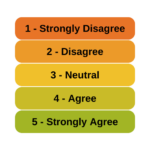 Is it really ok to treat Likert items as continuous?
Is it really ok to treat Likert items as continuous?  And can you just decide to combine Likert items to make a scale? Likert-type data is extremely common—and so are questions like these about how to analyze it appropriately.
And can you just decide to combine Likert items to make a scale? Likert-type data is extremely common—and so are questions like these about how to analyze it appropriately.
In this training, you will learn how to make decisions about the analysis of these variables. We’ll specifically discuss the types of analyses that are appropriate for analyzing individual Likert items, reasonable assumptions to make when running these analyses, and methods that come in handy when combining Likert items into a scale.
Note: This training is an exclusive benefit to members of the Statistically Speaking Membership Program and part of the Stat’s Amore Trainings Series. Each Stat’s Amore Training is approximately 90 minutes long.
Date and Time
**** The live webinar has already taken place ****
About the Instructor
 Kim is a Statistically Speaking mentor and workshop instructor for The Analysis Factor. She is also owner/lead consultant at K.R. Love Quantitative Consulting and Collaboration.
Kim is a Statistically Speaking mentor and workshop instructor for The Analysis Factor. She is also owner/lead consultant at K.R. Love Quantitative Consulting and Collaboration.
She has worked as a statistical consultant and collaborator in multiple professional roles, most recently as the associate director of the University of Georgia Statistical Consulting Center.
Kim has more than a decade of professional and academic experience in the fields of regression and linear models, categorical data, generalized linear models, mixed effects models, nonlinear models, repeated measures, and experimental design. She has a B.A. in mathematics from the University of Virginia, and an M.S. and PhD in statistics from Virginia Tech.
Just head over and sign up for Statistically Speaking.
You'll get access to this training webinar, 130+ other stats trainings, a pathway to work through the trainings that you need — plus the expert guidance you need to build statistical skill with live Q&A sessions and an ask-a-mentor forum.

Interested in Lickert and IRT response theory Missing for Statisticians